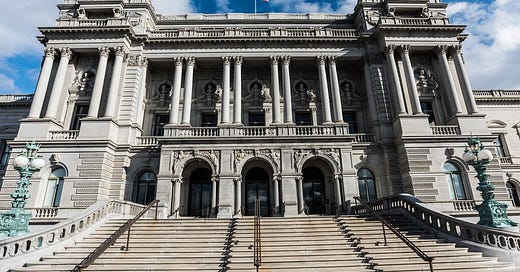
I have been on the apartment hunt, and one style of building was so attractive to me that I was willing to look past a communal laundry room: Beaux-Arts. Given my penchant for theatrical grandeur, this makes sense.
D.C. is rife with dueling architectural styles. One downtown square block can showcase Brutalism, Neoclassical, and French Beaux-Arts. The higgledy-piggledy effect is often derided, but I love the way the buildings stand out from each other, the widely varying visual interest passersby can enjoy by just looking up. The building I am going to end up living in is a funny blend itself, with an Art Deco façade and Beaux-Arts interior elements.
In researching Beaux-Arts architecture in D.C., I discovered Architect of the Capitol, the original AOC and organization dedicated to maintaining the Capitol buildings and grounds. Many of the buildings in their care are in the Beaux-Arts style, which the AOC describes as a “theatrical and heavily ornamented classical style taught during the 19th century at the Ecole des Beaux-Arts in Paris.”
Think large, flat topped or domed stone buildings with neoclassical sculptural elements, symmetry, columns, and a raised first floor. This raised ground level is a characteristic of an architectural concept called “hierarchy of space,” which literally elevates the most important rooms of the structure, giving visitors an elongated moment of entry to feel a sense of gravitas, often leading to a grand entryway with a flowing staircase, vaulted ceilings, arches, and interior stonework. Union Station, the Library of Congress and the Russell Senate and Cannon House office buildings are all great examples of the style. For all their fussiness, Beaux-Arts buildings are functional at the core, the decorative flourishes venerating the work that will be done inside.
Speaking of the inside, the Beaux-Arts style of interior decorating is just as grand, employing marble, granite, bronze, gold, and mahogany to a rich, layered, weighty effect.
One way to recognize a potential Beaux-Arts building from the outside is to look for a rusticated first level. Rustication is the intentional texturizing of the outward facing side of an otherwise smooth stone façade by a mason. This ancient technique is meant to give visual weight to the ground floor of a building, providing contrast with the smooth stonework above, which, in Beaux-Arts style, is a canvas for sculptural elements featuring the likes Greek and Roman gods, goddesses, and philosophers.
Is there an architectural style you’d like to learn more about or a building whose style you’d like me to ID? Let me know!
Until next week,
Elizabeth
This newsletter is just one facet of Zhuzh, my platform dedicated to conscious consumption and making space for delight. I offer secondhand-and-vintage-based wardrobe and interior styling services, art curation, and super chill life coaching. Keep up with me on Instagram and learn more at www.zhuzhlife.com.



